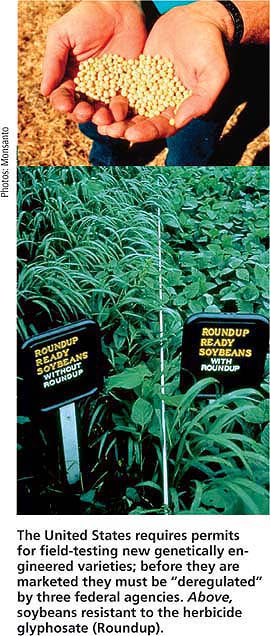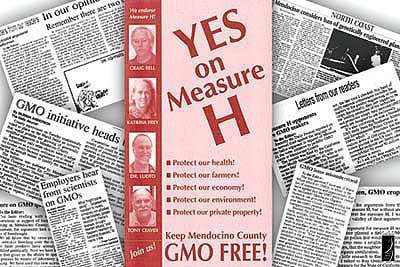All Issues
Transgenic acreage grows amid changing regulation
Publication Information
California Agriculture 58(2):72-73.
Published April 01, 2004
PDF | Citation | Permissions
Full text
Acreage in genetically engineered (GE) crops has increased steadily since their introduction in 1996, to 167 million acres worldwide in 2003. However, these crops remain controversial: advocates say they will help people and the environment but opponents fear they will hurt both. Regulations for producing, trading and labeling GE organisms are still evolving at the international, national and even local levels. Most recently, on March 2 California's Mendocino County became the first in the nation to ban production of GE plants and animals.
“New technology needs to be reviewed case-by-case until we're comfortable with it,” says Norman Ellstrand, a UC Riverside geneticist and director of the UC Biotechnology Impacts Center.
Virtually all commercial GE crops are either herbicide-tolerant or pest-resistant. The United States is the largest producer of the 18 countries that grow GE crops, followed by Argentina, Canada and China. In 2003, significant portions of the worldwide harvest in four commodities were genetically engineered: 55% of soybeans, 21% of cotton, 16% of canola and 11% of corn, according to a 2003 report by ISAAA (International Service for the Acquisition of Agri-biotech Applications).
The United States requires permits for field-testing new genetically engineered varieties; before they are marketed they must be “deregulated” by three federal agencies. Above, soybeans resistant to the herbicide glyphosate (Roundup).
Three-part regulatory process
New technologies bring new regulations. The United States currently requires permits for field-testing GE varieties during their development; then, companies wishing to commercialize GE crops must pass a three-part regulatory-approval process that involves the U.S. Environmental Protection Agency, U.S. Department of Agriculture (USDA) and U.S. Food and Drug Administration (page 106).
“People need to know that there is oversight,” says Christine Bruhn, director of the Center for Consumer Research at UC Davis. “The risks need to be acknowledged and controlled. Public education on the benefits is also key.”
However, regulations can also hamper the development of GE crops. “Regulations can make it too expensive for the smaller market crops,” says Kent Bradford, director of the Seed Biotechnology Center at UC Davis. Many of these (primarily horticultural) crops require dozens of varieties to match growing seasons and market preferences. U.S. regulations stipulate that a GE version of each variety must be registered separately. Alternatively, a single GE version may be registered and then the trait can be crossed into each of the varieties, but this is also time-consuming and expensive, Bradford says.
“By contrast, Canadian regulations focus on the safety and impact of the trait itself rather than on where it came from,” Bradford notes. “No distinction is made between genetic engineering and conventional breeding in evaluating whether a novel trait may be introduced into the marketplace.”
USDA to revise rules.
On Jan. 22, the USDA announced plans to update and strengthen U.S. biotechnology regulations, which cover the importation, interstate movement and environmental release of GE organisms. “The science of biotechnology is continually evolving, so we must ensure that our regulatory framework remains robust by anticipating and keeping pace with those changes,” U.S. Agriculture Secretary Ann Veneman said.
Since 1987, more than 10,000 GE organisms have been field-tested and more than 60 have been “deregulated.” Currently, GE crops are no longer regulated once they have been approved for commercial production.
The move to update U.S. regulations coincided with the release of a National Research Council report on “bioconfinement” ( see box, page 73 ). USDA sponsored the report because a number of GE organisms (such as transgenic fish) now exist that had not yet been developed when the current biotechnology regulations were established in 1986.
The proposed regulatory changes would include a requirement for ongoing monitoring of GE organisms after deregulation, and the development of a multitiered permitting system that both streamlines the approval of crops for commercial production and provides more oversight for the riskiest GE organisms.
Mendocino County ban.
On March 2, Mendocino County passed Measure H with 56% of the vote, making it the first county nationwide to ban growing GE plants and animals. The measure's supporters included the owners of an organic brewpub in Ukiah, who wanted to protect the county's organic produce industry from genetic contamination. Organic producers are prohibited from using GE organisms or ingredients.
The new ban has little immediate practical significance because no GE crops are currently grown in Mendocino County. “The measure and the vote were largely symbolic,” Bradford says. However, he added, the ban does set a precedent. “If similar measures pass in counties where GE crops such as herbicide-tolerant or insect-resistant (Bt) cotton are grown, that could increase the costs of pesticide use and labor and make California farmers less competitive.”
Groups in other California counties, including Humboldt and possibly Sonoma, Santa Cruz and El Dorado, are expected to start trying to qualify similar initiatives for the November 2004 ballot. In addition, Measure H opponents are considering challenging the Mendocino initiative in court.
U.S. labeling movement.
The U.S. currently does not require labeling for foods that contain GE ingredients. In July 2003, U.S. Representative Dennis Kucinich (D-Ohio) introduced a House bill that would require food companies to label all foods containing GE material. In addition, Barbara Boxer (D-Calif.) is expected to introduce this bill to the Senate by the end of the year.
International trade
After biotech crops are developed, approved and planted in the United States, they cannot be shipped to other nations without approval from each importing country. These rules can vary significantly from country to country. Some major trade partners of the United States have taken a precautionary approach toward allowing new biotech crops: Europe has had a moratorium for 5 years, while Japan approves them on a case-by-case basis.
Cartagena Protocol on Biosafety.
This global treaty helps member countries regulate the movement of GE organisms across national borders. The protocol established a biosafety clearinghouse that allows member nations to ban GE products that lack safety information, and requires labeling for international shipments. Effective in September 2003, the protocol is a supplement to the 1992 U.N. Convention on Biological Diversity.
As of March, 87 parties, including the European Community, India and the United Kingdom, had ratified the Cartagena Protocol. Countries that have not ratified it include the United States, China and the Russian Federation. Countries that are not members must still adhere to the protocol's provisions when shipping GE products to participating nations. In February, protocol members adopted two new documentation requirements for bulk agricultural shipments.
Left, in March 2004, Mendocino County passed Measure H, which bans the growing of genetically engineered plants and animals. Proponents were concerned about cross-contamination of organic crops by biotech seeds and crops.
European Union and Britain.
In January, the European Commission ended its 5-year moratorium on new GE foods by approving the sale of canned, frozen and fresh GE sweet corn. (These corn products are already approved in the United States, Canada, Australia and Switzerland.) E.U. members have 3 months to endorse or reject the commission's approval. Britain is currently considering allowing the cultivation of GE corn; Germany and Spain are the only E.U. countries that grow GE crops.
NRC recommends “bioconfinement” measures
On Jan. 20, a committee of the National Research Council (NRC) released “Biological Confinement of Genetically Engineered Organisms,” a USDA-sponsored report calling for measures to prevent genetically engineered (GE) organisms from escaping into ecosystems or from passing engineered traits to other species.
The NRC committee's concerns included that GE crops could pass pesticide or disease resistance to weedy relatives, making them invasive; GE organisms could breed with or out-compete their wild relatives; and species engineered to produce pharmaceuticals could harm people or animals that eat them by mistake.
“Some things, such as future pharmaceutical crops, will need to be grown under regulation,” says UC Riverside geneticist Norman Ellstrand, director of the UC Biotechnology Impacts Center and a member of the NRC committee.
Bioconfinement methods for plants include inserting genes that make them sterile or that keep them from producing pollen. “Confinement won't be warranted in most cases, but when it is, worst-case scenarios and their probabilities should be considered,” said NRC committee chair Kent Kirk, professor emeritus of the University of Wisconsin, Madison.
The NRC committee's recommendations included:
-
More research should be conducted about how bioconfinement methods work.
-
More than one bioconfinement method should be used, because no single method is likely to be completely effective.
-
Combinations of bioconfinement methods should be tested on representative organisms in a variety of environments.
R. M.






